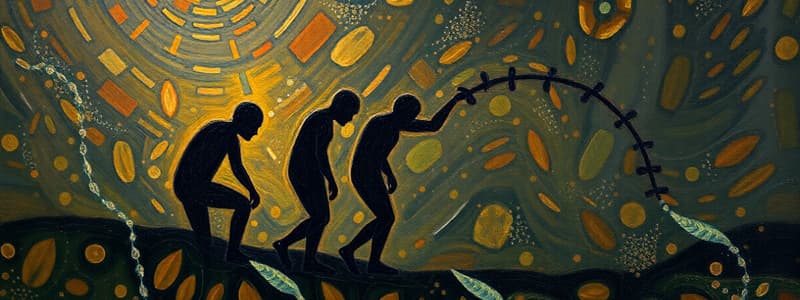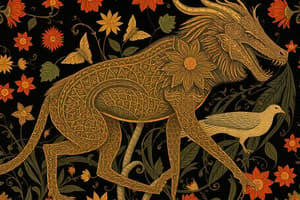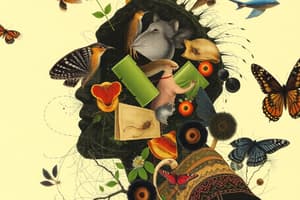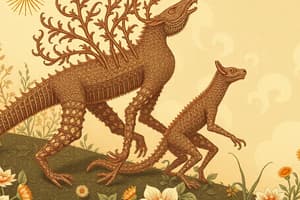Podcast
Questions and Answers
Which of the following is an example of ex situ conservation?
Which of the following is an example of ex situ conservation?
- Seed banks (correct)
- National parks
- Marine protected areas
- Wildlife reserves
The EDGE program focuses on species that are both evolutionarily distinct and globally endangered.
The EDGE program focuses on species that are both evolutionarily distinct and globally endangered.
True (A)
What is rewilding?
What is rewilding?
Restoring ecosystems to their natural state.
The two types of conservation methods are in situ and ______.
The two types of conservation methods are in situ and ______.
Match the type of variation with its definition:
Match the type of variation with its definition:
Which of the following is NOT a source of genetic variation?
Which of the following is NOT a source of genetic variation?
All types of variation are only due to genetic factors.
All types of variation are only due to genetic factors.
Define binomial nomenclature.
Define binomial nomenclature.
Which statement best describes the biological species concept?
Which statement best describes the biological species concept?
The diploid chromosome number in organisms is typically odd.
The diploid chromosome number in organisms is typically odd.
What is a karyotype?
What is a karyotype?
A _____ is a tool used for species identification based on step-by-step traits.
A _____ is a tool used for species identification based on step-by-step traits.
Match the terms with their definitions:
Match the terms with their definitions:
What is one ethical consideration related to genome sequencing?
What is one ethical consideration related to genome sequencing?
What chromosome number is typical for humans?
What chromosome number is typical for humans?
Horizontal gene transfer facilitates the application of the biological species concept in bacteria.
Horizontal gene transfer facilitates the application of the biological species concept in bacteria.
What do analogous structures indicate about the species that possess them?
What do analogous structures indicate about the species that possess them?
Allopatric speciation occurs when populations geographically separate to form new species.
Allopatric speciation occurs when populations geographically separate to form new species.
Define biodiversity.
Define biodiversity.
Adaptive radiation leads to increased biodiversity by allowing species to exploit __________.
Adaptive radiation leads to increased biodiversity by allowing species to exploit __________.
Match the following types of reproductive isolation with their descriptions:
Match the following types of reproductive isolation with their descriptions:
Which mechanism prevents gene mixing between species after fertilization?
Which mechanism prevents gene mixing between species after fertilization?
Hybrid species, such as mules, are typically fertile and can reproduce.
Hybrid species, such as mules, are typically fertile and can reproduce.
What is the primary cause of the current biodiversity crisis?
What is the primary cause of the current biodiversity crisis?
Which statement best defines evolution?
Which statement best defines evolution?
Darwin's theory of natural selection did not fundamentally change the field of biology.
Darwin's theory of natural selection did not fundamentally change the field of biology.
What is the main difference between Lamarckism and Darwinian evolution?
What is the main difference between Lamarckism and Darwinian evolution?
The similarity of DNA, RNA, and ____ provides evidence for evolutionary relationships among species.
The similarity of DNA, RNA, and ____ provides evidence for evolutionary relationships among species.
Which of the following is an example of artificial selection?
Which of the following is an example of artificial selection?
Homologous structures serve the same function in different species but arise from different ancestries.
Homologous structures serve the same function in different species but arise from different ancestries.
Explain how the pentadactyl limb exemplifies divergent evolution.
Explain how the pentadactyl limb exemplifies divergent evolution.
Match the following concepts with their appropriate descriptions:
Match the following concepts with their appropriate descriptions:
Flashcards
Evolution
Evolution
A change in the heritable characteristics of a population over generations.
Lamarckism
Lamarckism
The idea that acquired traits can be passed down to offspring; disproven by modern biological evidence.
Natural Selection
Natural Selection
The process by which organisms better adapted to their environment survive and reproduce more successfully, passing on their beneficial traits.
Molecular Evidence for Evolution
Molecular Evidence for Evolution
Signup and view all the flashcards
Artificial Selection
Artificial Selection
Signup and view all the flashcards
Homologous Structures
Homologous Structures
Signup and view all the flashcards
Divergent Evolution
Divergent Evolution
Signup and view all the flashcards
Analogous Structures
Analogous Structures
Signup and view all the flashcards
Speciation
Speciation
Signup and view all the flashcards
Allopatric Speciation
Allopatric Speciation
Signup and view all the flashcards
Sympatric Speciation
Sympatric Speciation
Signup and view all the flashcards
Adaptive Radiation
Adaptive Radiation
Signup and view all the flashcards
Biodiversity
Biodiversity
Signup and view all the flashcards
Barriers to Hybridization
Barriers to Hybridization
Signup and view all the flashcards
Biodiversity Crisis
Biodiversity Crisis
Signup and view all the flashcards
In situ conservation
In situ conservation
Signup and view all the flashcards
Ex situ conservation
Ex situ conservation
Signup and view all the flashcards
EDGE of Existence program
EDGE of Existence program
Signup and view all the flashcards
Rewilding
Rewilding
Signup and view all the flashcards
Morphological species concept
Morphological species concept
Signup and view all the flashcards
Binomial nomenclature
Binomial nomenclature
Signup and view all the flashcards
Variation
Variation
Signup and view all the flashcards
Organisms
Organisms
Signup and view all the flashcards
Biological Species Concept
Biological Species Concept
Signup and view all the flashcards
Genome
Genome
Signup and view all the flashcards
Gene
Gene
Signup and view all the flashcards
Allele
Allele
Signup and view all the flashcards
Karyotype
Karyotype
Signup and view all the flashcards
Karyogram
Karyogram
Signup and view all the flashcards
Horizontal Gene Transfer
Horizontal Gene Transfer
Signup and view all the flashcards
Study Notes
Evolution, Speciation, and Biodiversity
- Evolution is the change in heritable characteristics of a population over generations.
- Lamarckism proposes inheritance of acquired traits, differing from Darwin's theory of natural selection.
- Natural selection is the mechanism of evolution where advantageous traits are passed on.
- Molecular evidence like DNA and protein sequences shows evolutionary relationships; the more similar the sequences, the closer the species.
- Sequence divergence correlates with evolutionary distance.
- Artificial selection is human-directed breeding for desirable traits.
- Homologous structures (e.g., pentadactyl limbs) share common ancestry despite different functions due to divergent evolution.
- Analogous structures arise from convergent evolution, where unrelated species evolve similar adaptations in similar environments.
- Speciation occurs with reproductive isolation (geographic, temporal, or behavioral).
- Allopatric speciation involves geographic separation; sympatric speciation occurs within overlapping ranges.
- Biodiversity encompasses species, genetic, and ecosystem variety.
- Past biodiversity levels were higher than current levels and were often impacted by mass extinctions.
- Anthropogenic (human-caused) activities threaten biodiversity.
- Conservation methods include in-situ (e.g., wildlife reserves) and ex-situ (e.g., zoos).
- Reproductive isolation plays a role in the divergence of species, often due to geographic isolation.
- Adaptive radiation increases biodiversity by allowing species to exploit new niches.
- Barriers to hybridization (pre-zygotic and post-zygotic) prevent gene mixing between species.
- Hybrid species often have reduced or no fertility.
Biodiversity and Extinction
- Biodiversity exists on multiple levels (species, genetic, and ecosystem).
- Past biodiversity was often greater than present levels due to historical events.
- Anthropogenic activities like habitat destruction, pollution, and climate change negatively impact biodiversity.
- Declining species richness and unhealthy ecosystems are signs of a biodiversity crisis.
Biodiversity Conservation
- Conservation efforts can be in situ (within natural habitats) or ex situ (outside habitats, such as zoos).
- The EDGE program prioritizes evolutionarily distinct and globally endangered species.
- Rewilding ecosystems to a natural state is a growing conservation strategy.
Variation as a Defining Feature of Life
- Variation is found within and between organisms due to genetic and environmental factors.
- Sources of genetic variations include mutations and sexual reproduction.
- Variation can be discrete (e.g., blood type) or continuous (e.g., height).
- Differences within species arise from shared genetics; between species from divergent evolution.
Species and Speciation
- Morphological species concept: organisms with shared physical traits.
- Binomial nomenclature: standardized system of naming organisms with genus and species.
- Biological species concept: groups of interbreeding organisms that produce viable fertile offspring.
- Species formation (speciation) is caused by reproductive isolation.
Chromosome Numbers and Karyotyping
- Chromosome number often distinguishes species.
- Karyotype is the arrangement of chromosomes ordered by size, banding patterns, and centromere position.
- Karyograms visually represent the karyotype.
- Human sex determination is XX (female), XY (male).
Genomes and Sequencing
- Genome is an organism's complete set of genetic material.
- Gene is the unit of heredity; allele is a variation of a gene.
- Genome size does not always correlate with organism complexity.
- Applications of genome sequencing are in medicine, agriculture, and evolutionary studies.
- Ethical concerns regarding genome sequencing exist concerning privacy, discrimination, and access to genetic information.
Advanced Concepts in Species Identification
- Horizontal gene transfer is common in bacteria, complicating the biological species concept.
- DNA barcoding and dichotomous keys are methods for identifying species, commonly used in conservation and tracking biodiversity studies.
Need for Classification
- Taxonomy is the science of classification.
- Traditional classification hierarchy: domain, kingdom, phylum, class, order, family, genus, species.
- Classification simplifies study and shows relationships among organisms, and their evolutionary relationships.
Modern Challenges and Evolutionary Relationships
- Convergent evolution can produce similar traits in unrelated species, making traditional classifications challenging.
- Clade is a group of organisms with a common ancestor, using shared traits through evolution.
Cladograms and Molecular Evidence
- Molecular clock uses DNA/protein sequence differences to estimate time of evolutionary divergence.
- Cladograms show evolutionary relationships through parsimony and bioinformatics.
- DNA sequences are frequently used to create cladograms.
Reclassification and Domains of Life
- Cladistics uses molecular data (e.g., rRNA) to reassess classifications.
- Three domains are Archaea, Bacteria, and Eukarya, representing an important branch of modern (phylogenetic) classification.
Studying That Suits You
Use AI to generate personalized quizzes and flashcards to suit your learning preferences.




